Activity and optimism at Expo Chicago attest to the city’s ‘fearless’ community of collectors and patrons
The vast festival halls of Navy Pier were crowded with collectors, curators, artists and other VIPs by the late afternoon on Thursday (24 April) for the preview of Expo Chicago (until 27 April). The fair’s 12th edition and second since it was acquired by the international fair and media company Frieze features more than 170 galleries from 36 countries, including a large contingent of South Korean galleries on hand with support from the Galleries Association of Korea. Expo Chicago also welcomed a significant cohort from Canada, Latin America and smaller US cities—from Miami, Aspen and Santa Fe to Minneapolis, Buffalo and San Francisco.
Chicago’s community of artists and galleries has pride of place, perhaps none more so than Rhona Hoffman, who will close her namesake gallery next month after nearly a half-century in business. Chicago’s mayor Brandon Johnson visited her stand at the centre of the fair during the preview’s opening hours to pay his respects. The stand’s exterior features, among other works, an abstract, texturally rich painting by the Chicago-based artist Amanda Williams, who spoke with the Museum of Contemporary Art Chicago’s senior curator, Jamillah James, during a panel on Thursday afternoon—virtually every seat was taken.
“Chicago audiences, institutions and collectors are fearless,” says Tony Karman, the fair’s president and director. “This is not a fair where exhibitors feel they have to bring pretty pictures—our audience likes being challenged visually, thematically and materially.”
A timely example of all three is taking up the entire stand of Los Angeles-based Walter Maciel Gallery, which is showing Locker Room (2011) by Nathan Vincent. The artist’s life-size re-creation of a generic men’s changing room—complete with benches, showers, urinals and two rows of lockers—is rendered entirely in knitted and crochet elements.
Nathan Vincent, Locker Room, 2011, presented by Walter Maciel Gallery Benjamin Sutton
“This project started for me as a piece about not feeling comfortable in spaces like this,” says Vincent. “I decided to render this stereotypically masculine space using materials and techniques that have historically been characterised as feminine.”
Fourteen years later, the artist says, his installation has only become more poignant. “When I made it in 2011, I thought this piece would eventually become irrelevant,” Vincent says. “But after the president described his demeaning comments about women as ‘locker room talk’, as his administration has pushed bathroom bans and targeted trans athletes, it has only become more relevant.” He adds that the gallery is hoping to place the installation in an institution or with “collectors who are frequent lenders to institutions”. Separately, individual knitted urinal sculptures are available.
Another arresting installation, which is part of the fair’s In Situ programme of large-scale interventions, is a collaborative video project by Deborah Oropallo and Andy Rappaport, presented by the San Francisco-based Catharine Clark Gallery. Rebellion (2021) features, on five freestanding video screens, a slowly shifting sequence of images of protesters from various demonstrations around the world.
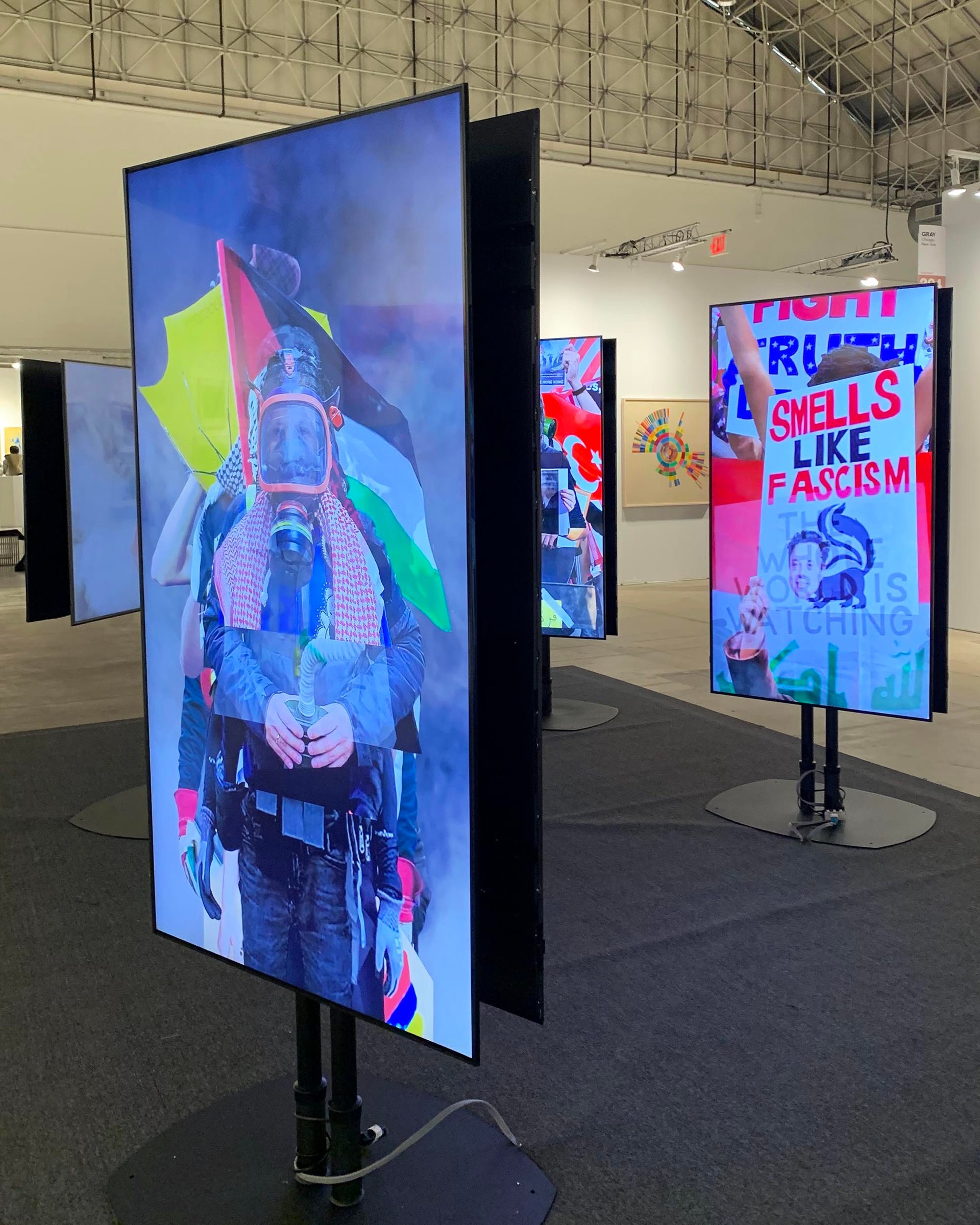
Deborah Oropallo and Andy Rappaport, Rebellion, 2021, presented by Catherine Clark Gallery Benjamin Sutton
“In this moment of global protests, they’re interested in the visual language of activism across movements—some of these images are from environmental protests, labour rallies or extremely specific political actions,” says Anton Stuebner, a partner and director at Catharine Clark Gallery. “Yet there is a shared formal language of activism. By slowing it down and presenting it at close to life size, they’re asking us to look at this imagery we’re familiar with from the news and social media in a new light.”
On its nearby stand, the gallery is showing a miniature survey of Oropallo’s work and collaborations across several decades, from paintings and photomontages to sculptures made with Michael Goldin and videos made with Rappaport and Jeremiah Franklin. Works on the stand range from $2,800 to $45,000.
Another stand featuring images fairgoers might recognise from news footage is that of the Dublin-based dealer Kevin Kavanagh, which is devoted to works by the Irish photographer Elaine Byrne focused on borders and priced from $3,100 to $7,500. The stand’s centrepiece is a pairing of two sets of eight photographs shot at the Mexico-US border: on one wall are images of the prototypes of US President Donald Trump’s border wall designs that were erected in 2017; facing them are photographs of the corresponding view to the south of the border, mostly of dusty alleys and piled debris.
“We had an opportunity to put this work in an exhibition in 2018, and Elaine and I agreed that it would have been in slightly bad taste,” Kavanagh says. “But now feels like the right time, given the political climate and situation at the border.” They were not the only ones feeling that way, apparently; within a few hours of the preview opening, one edition of Byrne’s Trump Prototype Walls, Mexico (2018) had sold.
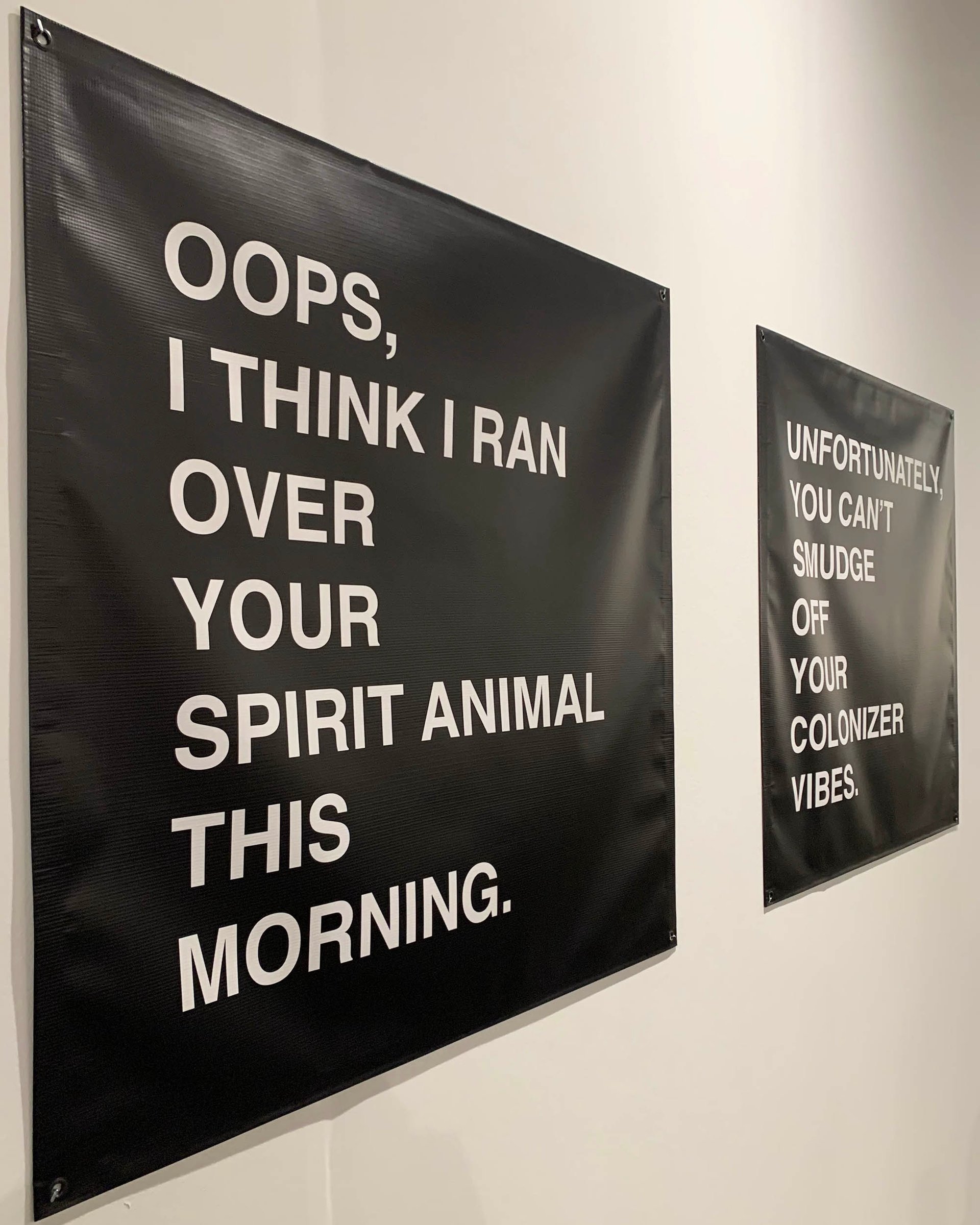
Works from Anna Tsouhlarakis’s series YOUR REFUSAL TO SEE: A Native Guide Project (2024) on the Center for Native Futures Benjamin Sutton
The US president’s policies—on economic, immigration and cultural issues—manifest in several ways across the fair. One exterior wall of the Center for Native Futures stand, for instance, features a series of vinyl banners bearing pointed, irreverent white-on-black text. One reads: “Unfortunately, you can’t smudge off your colonizer vibes.” The works come from a series by the Colorado-based Navajo, Creek and Greek artist Anna Tsouhlarakis titled YOUR REFUSAL TO SEE: A Native Guide Project (2024).
“These works felt appropriate for this setting, because her work expresses a lot of things that we wish we could say,” says Debra Yepa-Pappan, the co-founder and director of the Center for Native Futures, Chicago’s only Indigenous-led art space. “For Native people, the current situation is nothing new—there has been and still is a cultural genocide happening.”
Another Chicago-based space, Anthony Gallery, is addressing—more obliquely—the US’s ongoing gun violence crisis. The gallery’s solo stand of works by the Los Angeles-based artist Kalan Strauss looks, at first glance, like an oddly sparse toy store. The walls and one shelving unit filled with dolls and action figures hold bright paintings of Super Soaker water guns in their neon-hued packaging. The series began after Strauss bought a 3D printer and became fixated on the social media community of people using the devices to print gun parts.
“I was interested in the nostalgia for Super Soakers, but also the ways that the advertising for them is very sexual,” Strauss says. “They’re very alluring as objects.” His photorealist paintings are similarly seductive, and priced between $3,000 and $5,000.
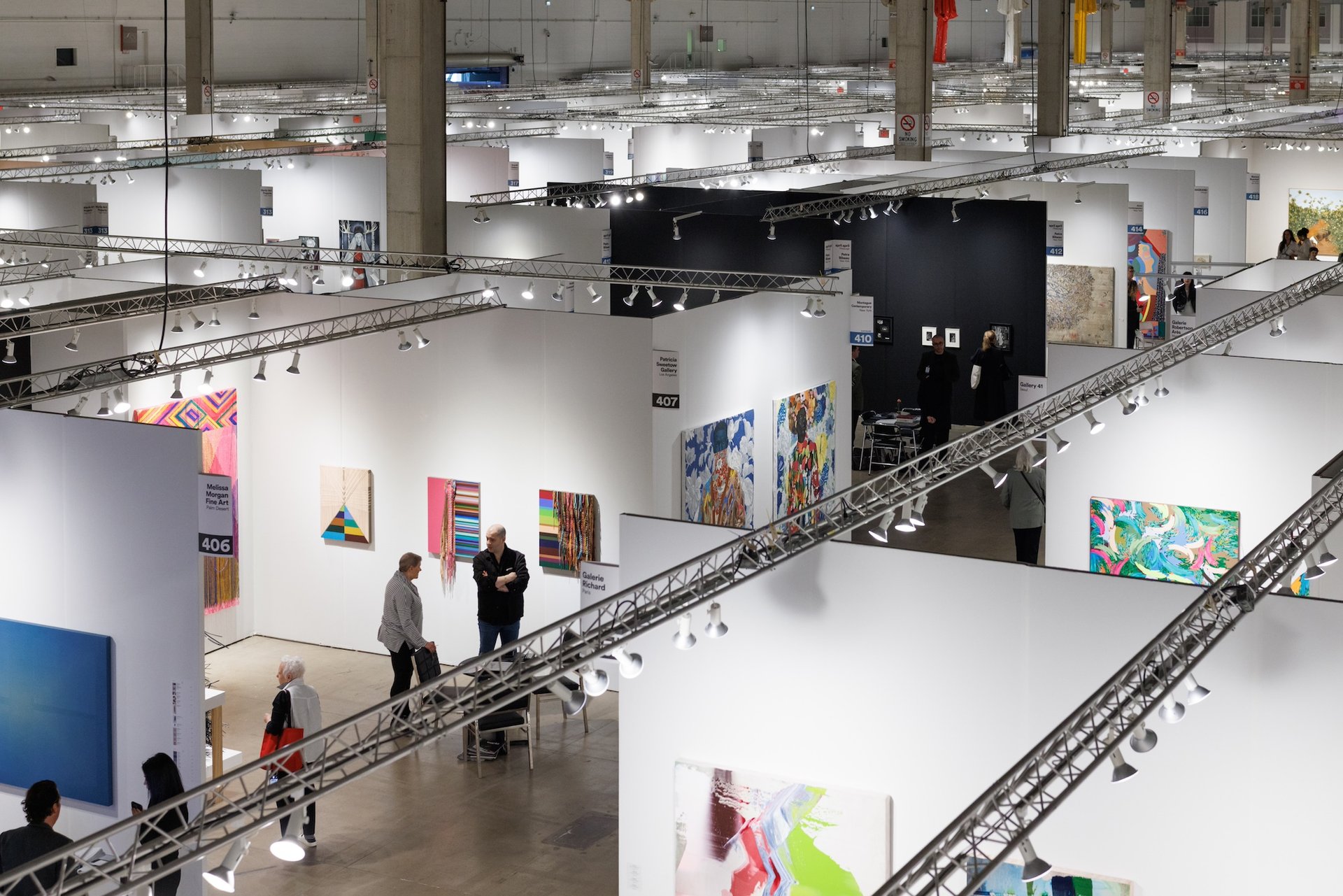
Visitors exploring the 2025 edition of Expo Chicago Photo Casey Kelbaugh, Courtesy of Expo Chicago
The political situation did not seem to dampen buyers’ moods too much, with more than 40 exhibitors reporting sales within the fair’s first two days, most of them in the five-figure range, with some four-figure works and a few in the six-figure range. Karman acknowledged that while the mood is upbeat and sales are happening, dealers may have adapted their expectations and offerings in light of the gloomy economic outlook brought on by Trump’s policies.
“There’s no question exhibitors are making business decisions in response to challenges that we are all feeling,” Karman says. “But they also know that they can go for it here, not dial it back, in terms of materials, formal qualities and subject matter.”
The London-based gallery Cristea Roberts Gallery sold a Josef Albers portfolio priced between $200,000 and $250,000, while another British dealership, Pippy Houldsworth Gallery, sold two paintings by the Chicago-based artist Wangari Mathenge for $90,000 and $100,000. The Chicagoan gallery Monique Meloche sold two works by Sanford Biggers, one in the range of $40,000 to $60,000 and the other for $50,000, a 2018 painting by Maia Cruz-Palileo for $50,000, and more. Sundaram Tagore, which has locations in New York, Singapore and London, sold a painting by the Korean artist Chun Kwang Young for $155,000, multiple works by the photographer Karen Knorr, and an Edward Burtynsky photograph for $27,000. The New York, Rio de Janeiro and São Paulo-based gallery Nara Roesler sold three works by the Brazilian artist Sérgio Sister during the VIP preview, for prices ranging from $7,600 to $40,000.
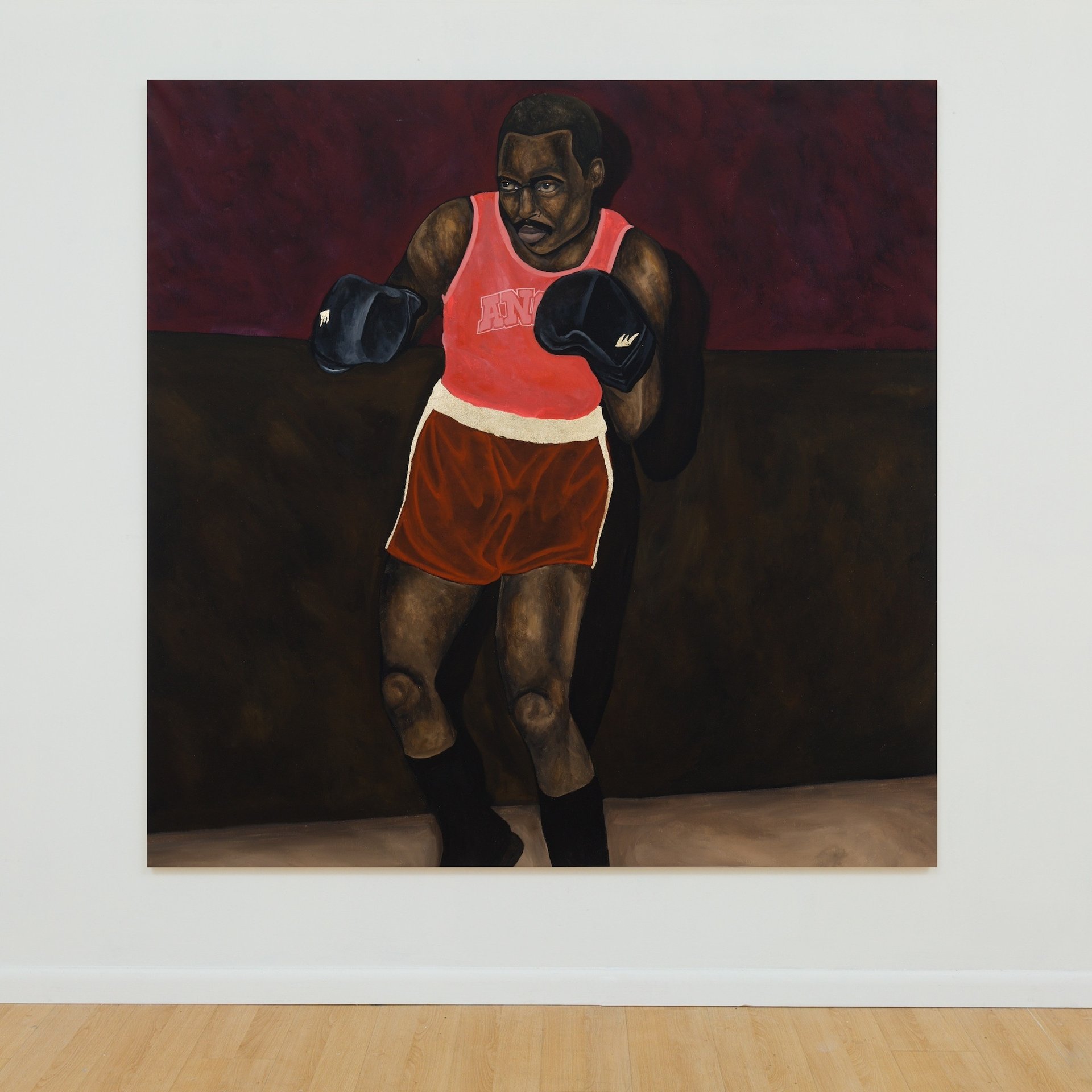
Auudi Dorsey, Rumble, 2025 Courtesy the artist and Palo Gallery
The New York-based Palo Gallery, participating in Expo Chicago for the first time, sold two works from its solo stand of paintings by the New Orleans-based artist Auudi Dorsey for $11,000 and $14,000 in the fair’s opening days. The canvases are inspired by the life of Clifford Etienne, a champion boxer now serving a 105-year prison sentence at the infamous Louisiana State Penitentiary.
“We’ve been wanting to engage with the community of institutions and collectors in the Midwest,” says Paul Henkel, Palo Gallery’s founder. “We applied because Auudi Dorsey had been wanting to show at this fair and because we know that the city and the fair are really important for Black art and Black collectors.” Remaining works on the stand are priced between $5,000 and $14,000.
Another first-time exhibitor, The Gallery of Everything from London, was likewise drawn by the industry’s generally high regard for Chicago’s community of collectors. In particular, the self-taught and folk art gallery was attracted to the city and the greater Midwest because of local collectors and institutions’ reputation for supporting that type of work. (The city’s artist-founded institution for self-taught artists, the Intuit Art Museum, will reopen next month following a $10m expansion and renovation.)
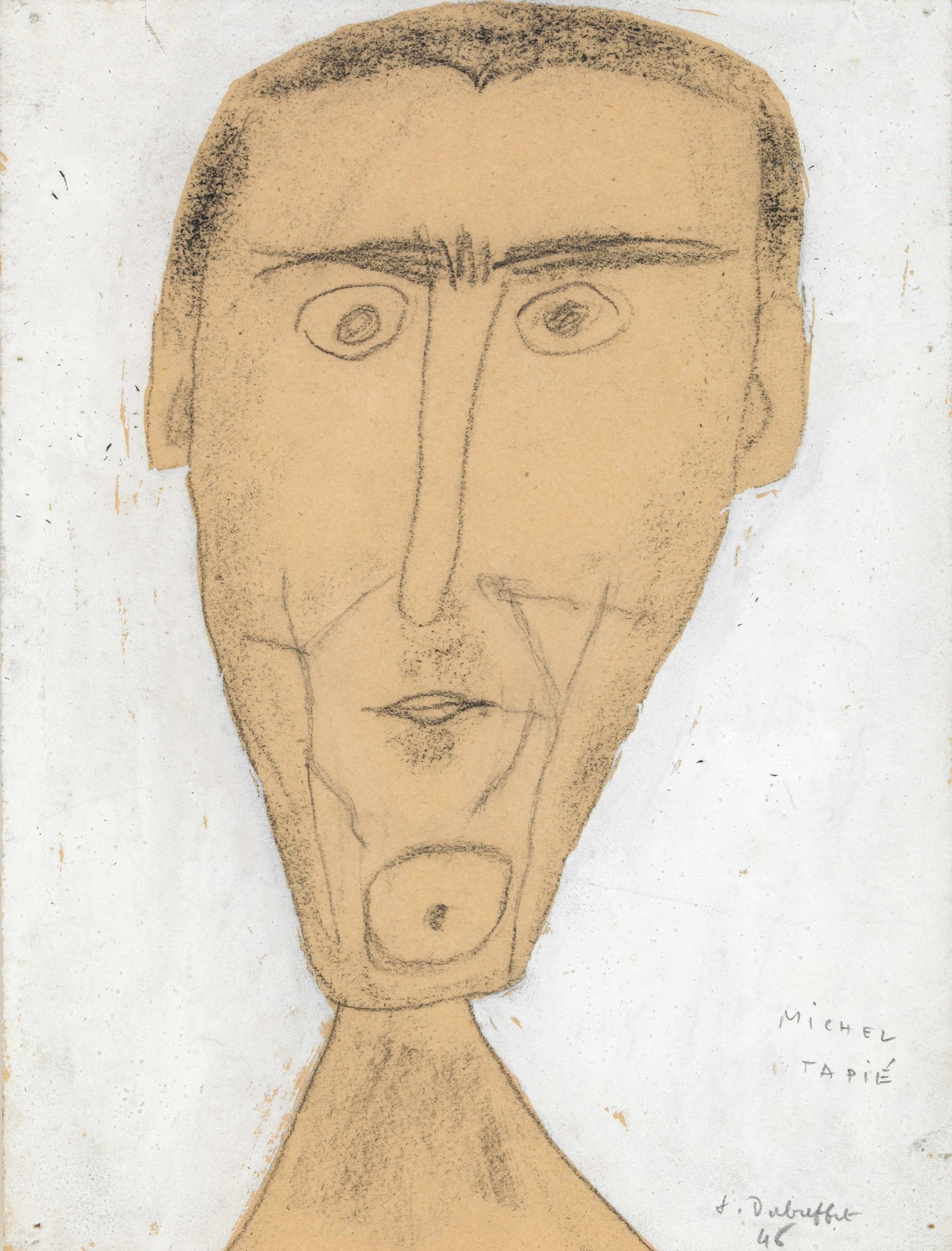
Jean Dubuffet, Michel Tapié, 1946 Courtesy The Gallery of Everything, London
“Chicago has such great outsider art patrons, I really think it’s the most important centre in America for self-taught and folk art,” says James Brett, the founder of the gallery, whose stand draws on Jean Dubuffet’s foundational role in coining the term Art Brut and formalising the genres of self-taught and folk art, including in a 1951 lecture at the Arts Club of Chicago. “We’ve had a tremendous response, all the way from Dubuffet collectors—including some who have really major collections of his early work—to contemporary art collectors, outsider art enthusiasts and people who are just curious and open to learning.” Works on the gallery’s stand are priced from $5,000 up to $300,000.
Three institutions made acquisitions from the fair through the support of the sponsor Northern Trust. The Birmingham Museum of Art in Alabama acquired two pieces: a painting by Lilian Martinez, Sunlit Realism (Paletas y Nieves) (2025), for $14,000 from the stand of Los Angeles- and Idaho-based gallery Ochi; and, from Torontonian gallery Patel Brown’s stand, a work on paper by Winnie Truong, The Body Keeps The Spore (2025), for $8,000. The Pennsylvania Academy of Fine Art in Philadelphia acquired three works from the stand of the local gallery Patron, by the Seoul-born, Chicago-based artist Soo Shin, priced from $3,000 to $10,000. And the Dallas Museum of Art acquired a canvas by the Brazilian artist Wallace Pato, Porta da Saudade (Door of longing, 2024), from Mitre gallery for $36,000.
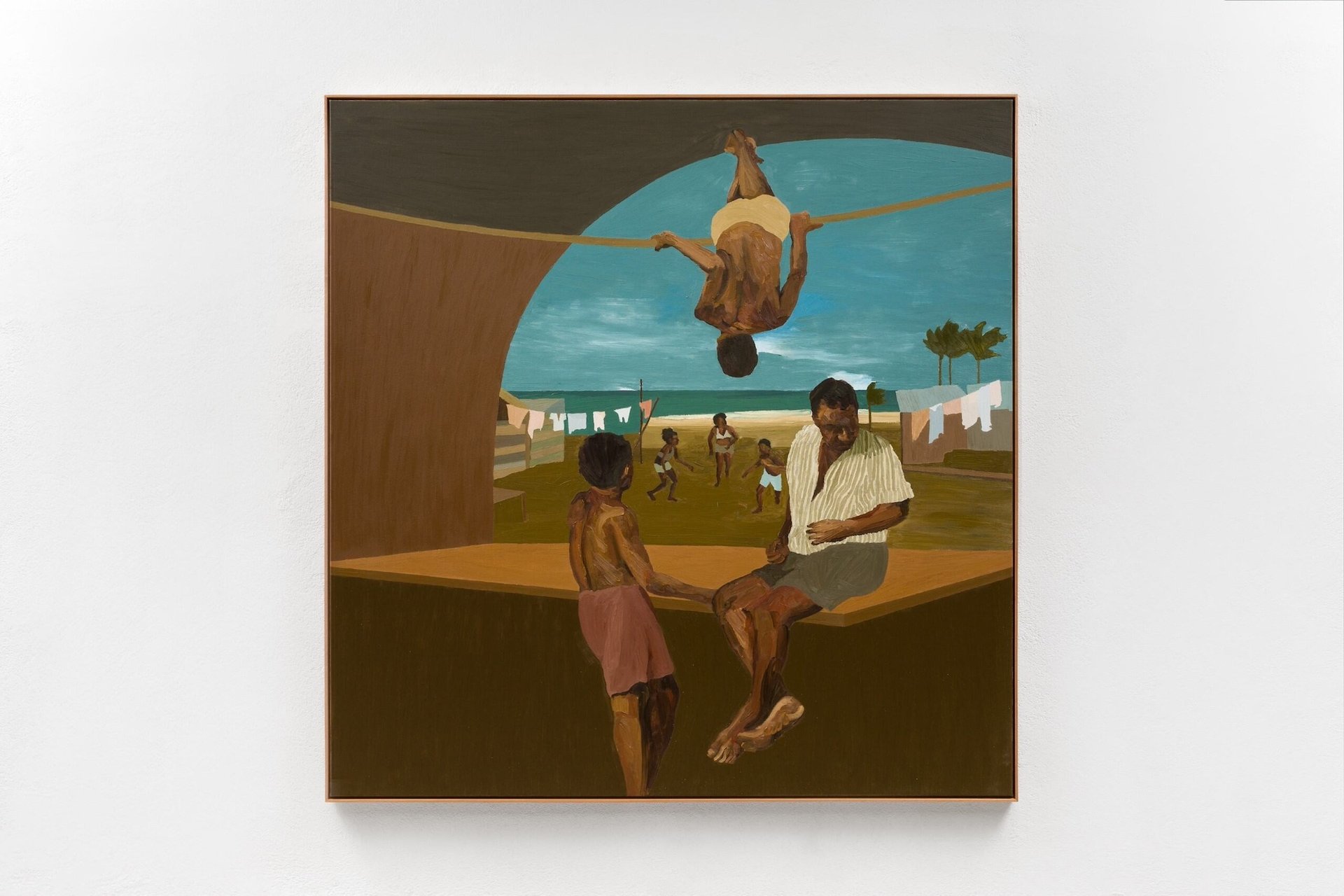
Wallace Pato’s Porta da Saudade (Door of longing) (2024), was acquired from Mitre’s stand by the Dallas Museum of Art through Expo Chicago’s Northern Trust Purchase Prize programme Courtesy the artist and Mitre
The painting “is representative of [Pato’s] practice of imaginative renderings of Brazilian vernacular scenes inflected with personal memory, representing an expanded context for Black figuration that will expand and enrich our museum’s encyclopedic holdings,” Katherine Brodbeck, the Dallas Museum of Art’s senior curator of contemporary art, said in statement.
“The mood here in Chicago is optimistic, despite the current political climate,” says Stephen Truax, a New York-based art adviser. “We’re seeing lots of new artists and unfamiliar artists’ estates—women, queer artists, artists of colour—and it’s exciting to see a marked departure from the tried and true names, and to see a variety of approaches moving away from the preponderance of figurative painting”
- Expo Chicago, until 27 April, Navy Pier, Chicago




